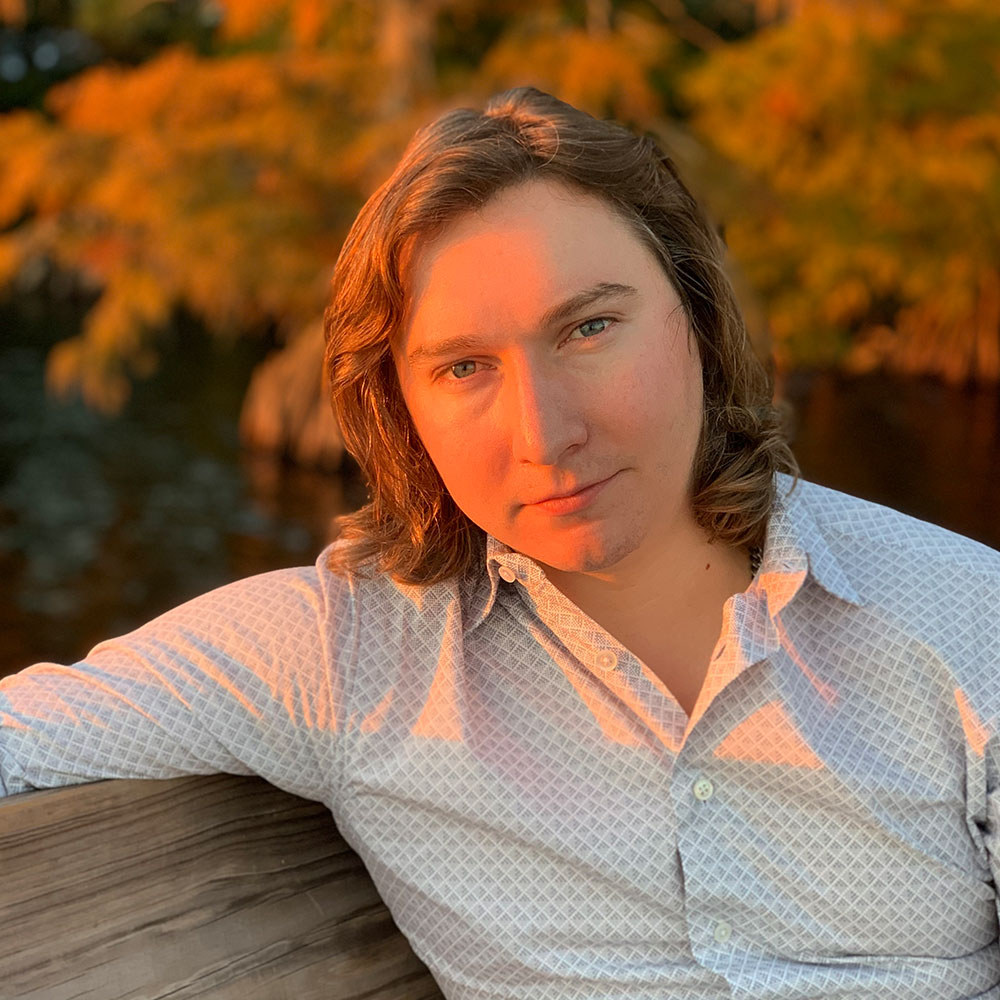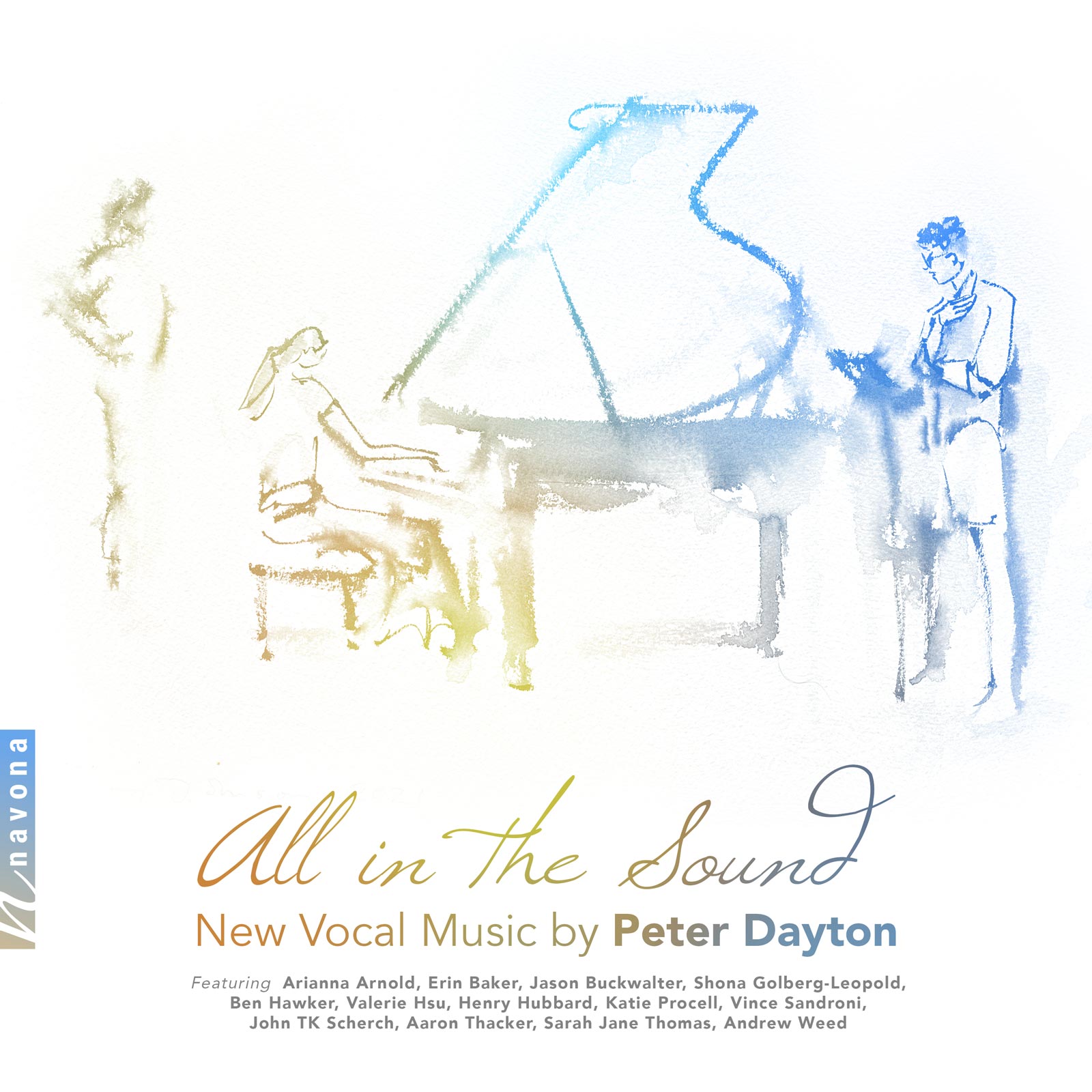
Following his 2022 release, STORIES OUT OF CHERRY STEMS, this latest collection of vocal music by Baltimore-based composer Peter Dayton reinforces his establishment as a mature and formidable talent in the world of art song. ALL IN THE SOUND captures the heart of the genre: duet between voice and accompaniment. Characteristically and integrally, Dayton’s songs exhibit internal compositional logics of pervasive rhythmic patterns and intervallic relationships that create music that still viscerally satisfies.
Today, Peter is our featured artist in “The Inside Story,” a blog series exploring the inner workings and personalities of our composers and performers. Read on to learn about his three-tiered love for vocal and chamber music, and the source of the unique artwork featured on his albums catalog page…
ALL IN THE SOUND’s liner notes touch on your compositional process of “developing an internal logic for each composition.” How did you first start taking this approach to writing new music, and how has it affected your creative process?
I think (like many composers of music in the Western Euro-American tradition since the 20th century) in the search for a sound that I could fully own, I felt I needed to find a way to personalize the elemental components of music. Rather than taking the grammatical principles of Common Practice Period music as the starting point for my music, I hope to create new musical grammar units with a core set of intervals for each piece. It’s still very much part of the Western Euro-American musical tradition, though, based in the 12-note chromatic spectrum, and due to that much of it will have the same sorts of chords and intervals as in music that explicitly uses major/minor/etc chords and scales as its musical components. If this method or explanation seems dry, it’s the context of the colors, intervals, interplay with the text, and timbres where this all comes alive.
ALL IN THE SOUND captures the heart of the art song genre: duet between voice and accompaniment. What attracted you to this compositional style, and what inspires you to keep pushing forward?
My love of chamber music and vocal music is part practical, part aesthetic, part relational. On the practical side, it’s easier to find and coordinate a soprano and violinist rather than a conductor and full orchestra! On the aesthetic side, I find that my creative process is driven by imposing creative limitations so that I don’t get stuck in a rut. The idiosyncrasies of non-piano instruments provide these sorts of creative limitations which continue to push my learning. I also love poetry and the ways that the setting of a text can suggest the form for a piece of music. The poem is its own kind of creative limitation on the piece of music. And while it might seem like this is part of the practical consideration, I have formed some very important collaborative relationships with vocalists, so continuing to grow those relationships by writing new music for my collaborators seems a worthier use of my time than to write pieces for ensembles I don’t have a connection to.
The album’s catalog page on Navona Records features some unique artwork from Douglas Johnson. What spawned these images, and how do they tie into the album? Have you collaborated with Johnson before?
Doug is my husband — so almost everything I do is a collaboration with him in a sense. His support to me throughout the rehearsal and recording process (and after, and daily) was and is essential. The artwork on the website, and in the virtual release video, is of the rehearsal and recording process for this album. My scores notate the intended sounds of the music, and Doug’s gorgeous India ink drawings notate the people who give the music life as they were doing it in real time. With as quiet a medium as an inkbrush, when I say that Doug was painting during the recording process, I mean that it was while we were live and recording, not just during the breaks. The artwork that Doug has produced for this and the previous album are definitely the biggest combination of our different artforms and I’m sure we’ll continue to have more projects and find new ways to combine our art.
What are some of your favorite musical moments on the album? Anything specific that listeners should focus on in terms of sound, repertoire, overall themes, or messages?
There’s something I love about every piece, both in sound and in what I was exploring creatively in the piece, and in how these amazing performers brought the music to life. Wilde Colours stands out in its timbre; because of canceled orchestral performances due to the pandemic, I was able to access a nearly brand-new Schiedmeyer 5.5 octave celesta for the recording. It’s a beautiful instrument and it was wonderful to work with the potential of the timbre beyond its typical fairytale/cinematic associations. But if there’s something that carries through most of the album that I’d like to highlight, it’s the relationship between sung vocal lines and those lines repeated by the instruments. The sung line imprints the meaning of the text on the music, and then the instrumental repetition carries the meaning of the sung line through it. This way the music can provide clarification, commentary, and juxtaposition as the poem continues linearly to its conclusion. Until the last track (which I wrote the lyrics for myself in a musical theatre style), none of the poems I set include refrains or repetitions of the text, which means that the music can play that refrain role and supplement the structure of the poem.
What’s next for you? Are there any new projects on the horizon that you’re particularly excited about?
I mentioned that my compositional choices are in part determined by my creative relationships and that continues to be true. I’m finding that, given my current active creative relationships, I’m moving towards writing much more chamber music for saxophone. Saxophonists are exciting to work with because there’s not quite as long a shadow of canonized repertoire — less history to have to try to struggle out from under in order to be heard in the present! And as I continue to work with vocal music, I’m hoping to write more for lower tessituras, have some Alto, Baritone, and Bass repertoire in addition to the hours of soprano music I have already written.

Described by American Record Guide as “...a composer whose heart and care are palpable... who has a voice that deserves to be heard often” and by the Baltimore Sun as having “a refined sense of melodic arcs and harmonic motion,” Peter Dayton’s compositions have been performed across North America and in Europe.

